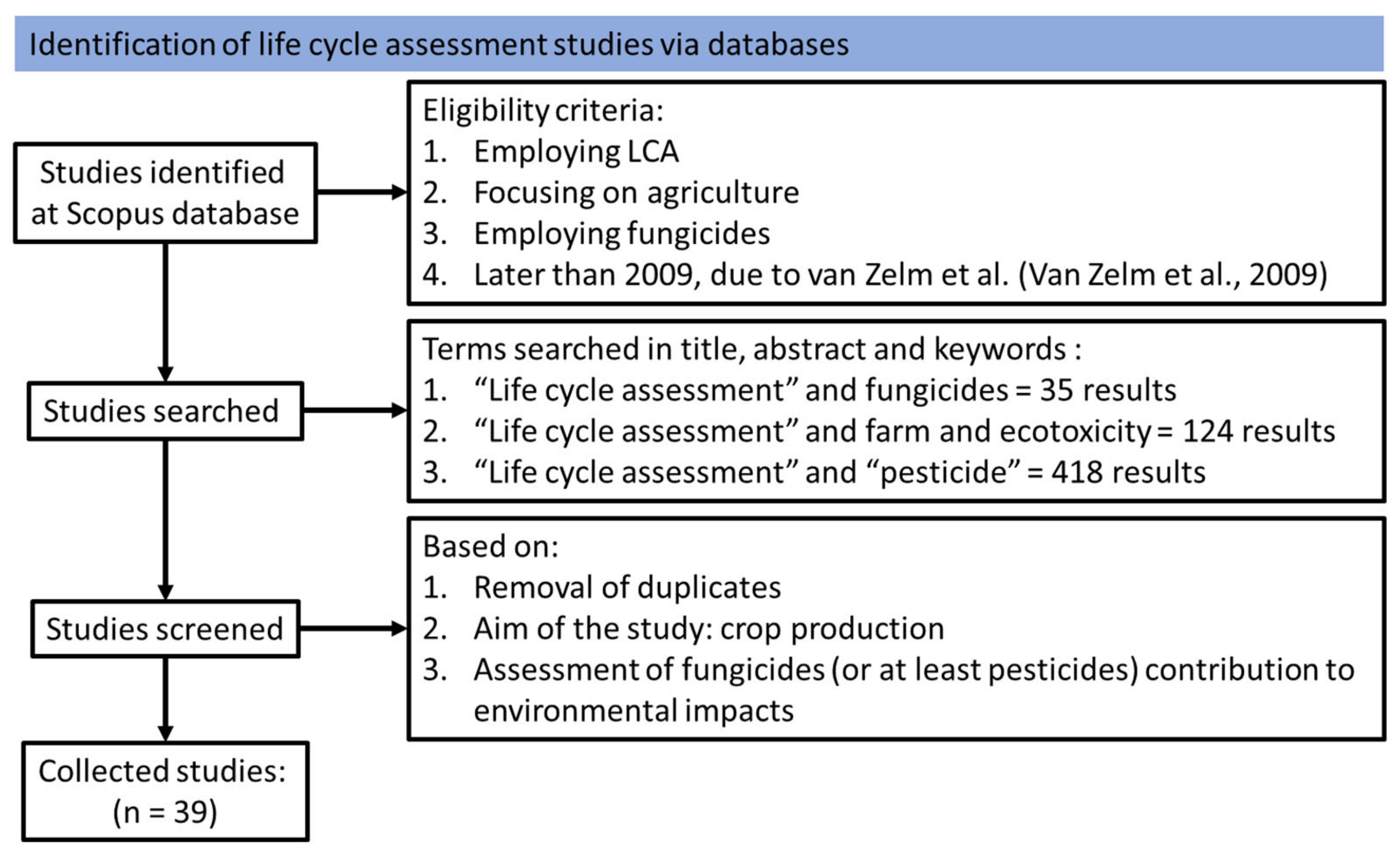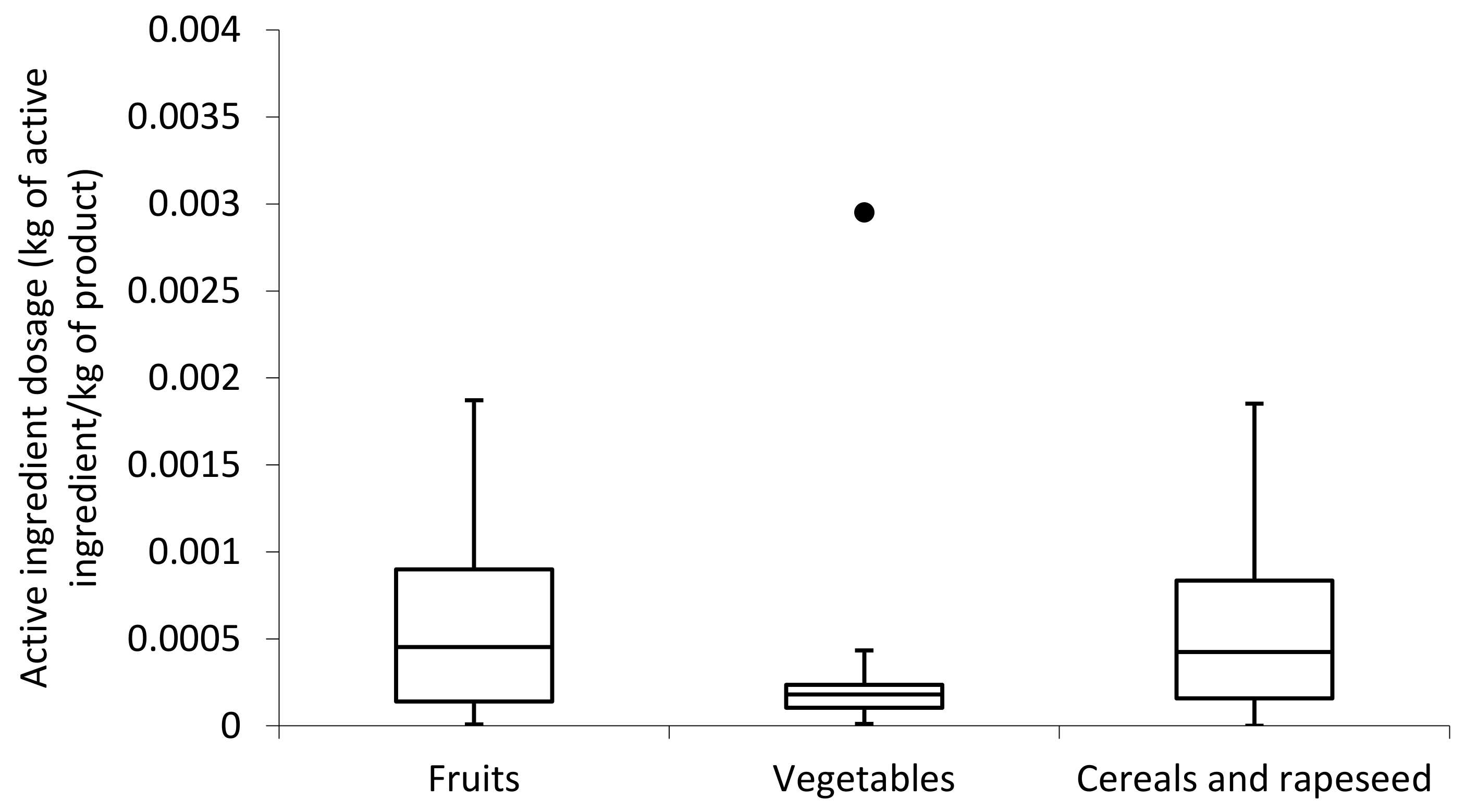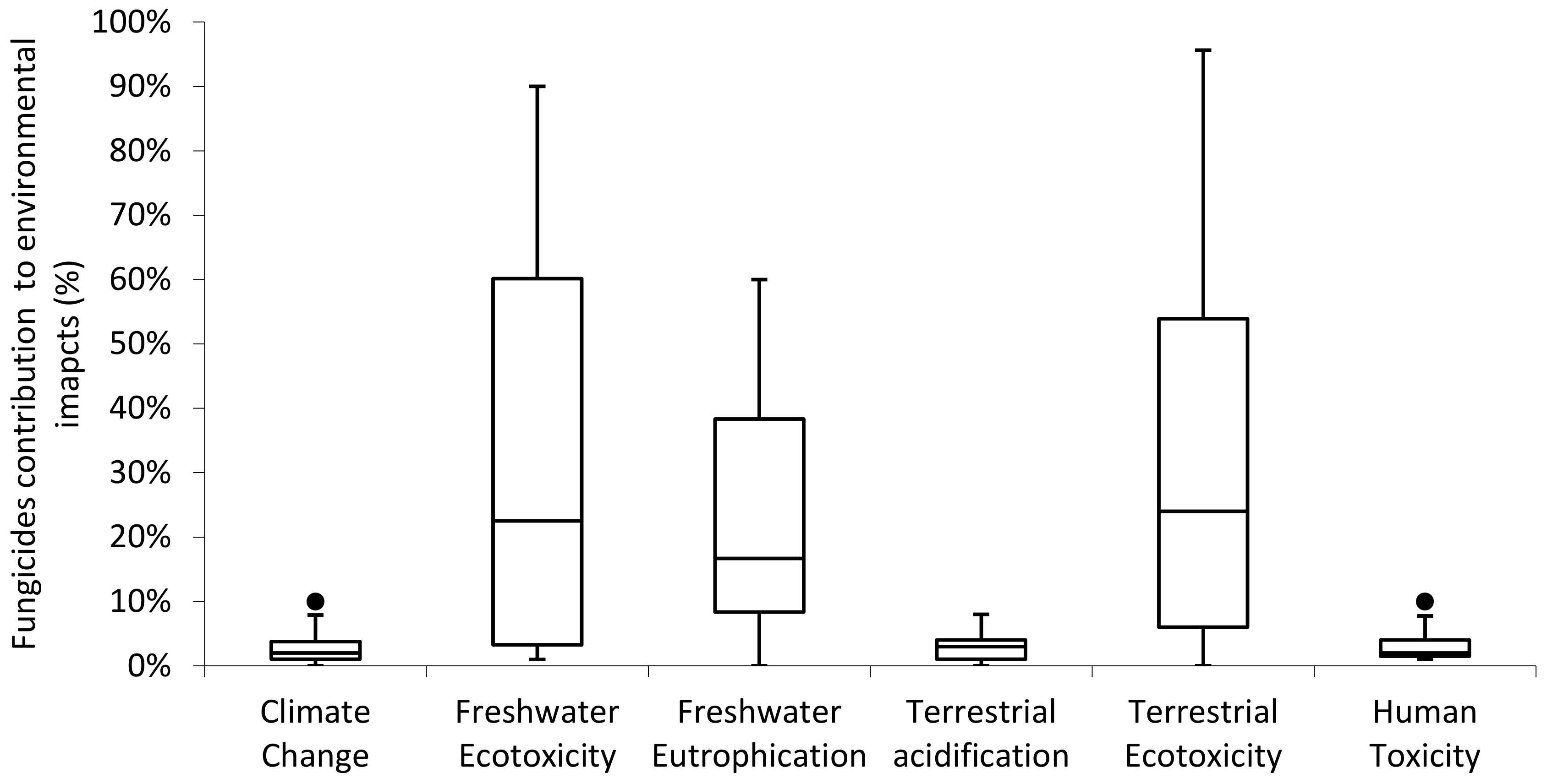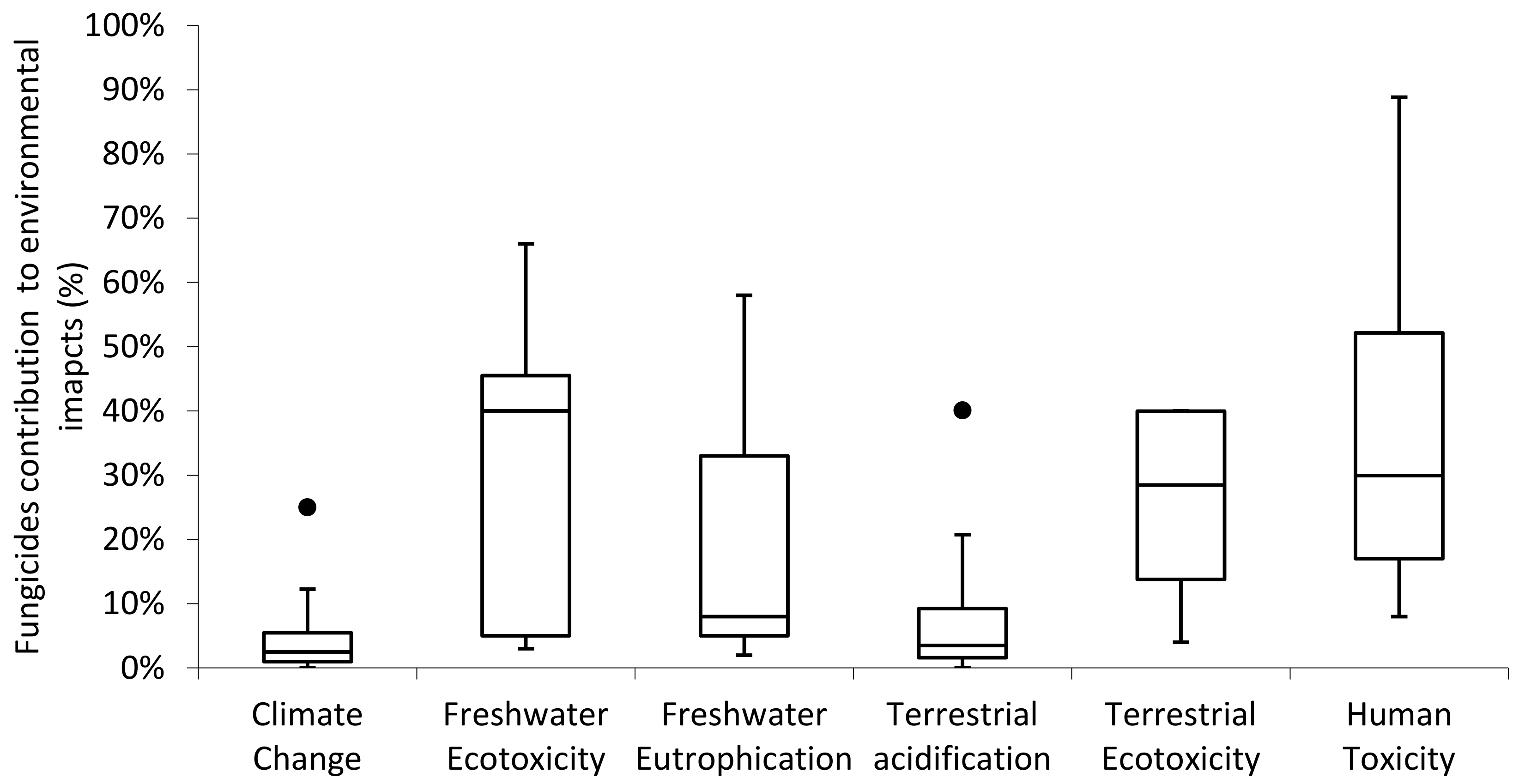Human Health and Ecosystem Quality Benefits with Life Cycle Assessment Due to Fungicides Elimination in Agriculture
Abstract
:1. Introduction
2. Materials and Methods
3. Results and Discussion
3.1. Active Ingredient
3.2. Dosage
3.3. Fungicides Contribution to Environmental Impacts
3.4. Endpoint Impacts Due to Fungicides Application
4. Conclusions
Supplementary Materials
Funding
Institutional Review Board Statement
Informed Consent Statement
Data Availability Statement
Acknowledgments
Conflicts of Interest
References
- Ehrlich, P.R. A personal view: Environmental education—Its content and delivery. J. Environ. Stud. Sci. 2011, 1, 6–13. [Google Scholar] [CrossRef]
- Muñoz, P.; Antón, A.; Núñez, M.; Paranjpe, A.; Ariño, J.; Castells, X.; Montero, J.; Rieradevall, J. Comparing The Environmental Impacts Of Greenhouse Versus Open-Field Tomato Production In The Mediterranean Region. Acta Hortic. 2008, 801, 1591–1596. [Google Scholar] [CrossRef]
- Winans, K.; Brodt, S.; Kendall, A. Life cycle assessment of California processing tomato: An evaluation of the effects of evolving practices and technologies over a 10-year (2005–2015) timeframe. Int. J. Life Cycle Assess. 2019, 25, 538–547. [Google Scholar] [CrossRef] [Green Version]
- D’Amico, G.; Szopik-Depczyńska, K.; Beltramo, R.; D’Adamo, I.; Ioppolo, G. Smart and Sustainable Bioeconomy Platform: A New Approach towards Sustainability. Sustainability 2022, 14, 466. [Google Scholar] [CrossRef]
- D’Adamo, I.; Gastaldi, M.; Morone, P.; Rosa, P.; Sassanelli, C.; Settembre-Blundo, D.; Shen, Y. Bioeconomy of Sustainability: Drivers, Opportunities and Policy Implications. Sustainability 2021, 14, 200. [Google Scholar] [CrossRef]
- OECD. Food and Agriculture Organization of the United Nations OECD-FAO Agricultural Outlook 2021–2030; OECD-FAO Agricultural Outlook; OECD: Paris, France, 2021; ISBN 978-92-64-43607-7. [Google Scholar]
- Aktar, W.; Sengupta, D.; Chowdhury, A. Impact of pesticides use in agriculture: Their benefits and hazards. Interdiscip. Toxicol. 2009, 2, 1–12. [Google Scholar] [CrossRef] [PubMed] [Green Version]
- Mazis, A.; Litskas, V.D.; Platis, D.P.; Menexes, G.C.; Anagnostopoulos, C.D.; Tsaboula, A.D.; Mamolos, A.P.; Kalburtji, K.L. Could energy equilibrium and greenhouse gas emissions in agroecosystems play a key role in crop replacement? A case study in orange and kiwi orchards. Environ. Sci. Pollut. Res. 2021, 28, 29421–29431. [Google Scholar] [CrossRef]
- Esteve-Turrillas, F.; de la Guardia, M. Environmental impact of Recover cotton in textile industry. Resour. Conserv. Recycl. 2017, 116, 107–115. [Google Scholar] [CrossRef]
- World Health Organization Pesticide Residues in Food. Available online: https://www.who.int/news-room/fact-sheets/detail/pesticide-residues-in-food (accessed on 18 December 2021).
- Juraske, R.; Sanjuán, N. Life cycle toxicity assessment of pesticides used in integrated and organic production of oranges in the Comunidad Valenciana, Spain. Chemosphere 2011, 82, 956–962. [Google Scholar] [CrossRef]
- Mesnage, R.; Defarge, N.; De Vendômois, J.S.; Séralini, G.-E. Major Pesticides Are More Toxic to Human Cells Than Their Declared Active Principles. BioMed Res. Int. 2014, 2014, 179691. [Google Scholar] [CrossRef] [Green Version]
- Moharram, A.M.; Abdel-Hafez, S.I.I.; El-Said, A.H.M.; Salee, A. Effect of Two Systemic Fungicides on Cellulose Decomposing Fungi of Tomato Plants and on Some Enzymatic Activities. Acta Microbiol. Immunol. Hung. 2004, 51, 403–430. [Google Scholar] [CrossRef] [PubMed]
- Sari, A.L.; Lubis, L. The effectiveness of contact fungicides mancozeb in controlling potato leaf blight disease (Phytophthora infestans (Mont) de Barry) in Karo District in the wet month and in the laboratory. In IOP Conference Series: Earth and Environmental Science; IOP Publishing: Bristol, UK, 2021; Volume 782. [Google Scholar]
- Benbrook, C.; Kegley, S.; Baker, B. Organic Farming Lessens Reliance on Pesticides and Promotes Public Health by Lowering Dietary Risks. Agronomy 2021, 11, 1266. [Google Scholar] [CrossRef]
- Gentil-Sergent, C.; Basset-Mens, C.; Renaud-Gentié, C.; Mottes, C.; Melero, C.; Launay, A.; Fantke, P. Introducing ground cover management in pesticide emission modeling. Integr. Environ. Assess. Manag. 2021, 18, 274–288. [Google Scholar] [CrossRef]
- van Calker, K.J.; Berentsen, P.B.M.; De Boer, I.M.J.; Giesen, G.W.J.; Huirne, R.B.M. An LP-model to analyse economic and ecological sustainability on Dutch dairy farms: Model presentation and application for experimental farm “de Marke”. Agric. Syst. 2004, 82, 139–160. [Google Scholar] [CrossRef]
- Wang, F.; Liu, Y.; Ouyang, X.; Hao, J.; Yang, X. Comparative environmental impact assessments of green food certified cucumber and conventional cucumber cultivation in China. Renew. Agric. Food Syst. 2018, 33, 432–442. [Google Scholar] [CrossRef]
- He, X.; Qiao, Y.; Liu, Y.; Dendler, L.; Yin, C.; Martin, F. Environmental impact assessment of organic and conventional tomato production in urban greenhouses of Beijing city, China. J. Clean. Prod. 2016, 134, 251–258. [Google Scholar] [CrossRef]
- Casolani, N.; Nissi, E.; Giampaolo, A.; Liberatore, L. Evaluating the effects of European support measures for Italian organic farms. Land Use Policy 2021, 102, 105225. [Google Scholar] [CrossRef]
- Purnhagen, K.P.; Clemens, S.; Eriksson, D.; Fresco, L.O.; Tosun, J.; Qaim, M.; Visser, R.G.; Weber, A.P.; Wesseler, J.H.; Zilberman, D. Europe’s Farm to Fork Strategy and Its Commitment to Biotechnology and Organic Farming: Conflicting or Complementary Goals? Trends Plant Sci. 2021, 26, 600–606. [Google Scholar] [CrossRef]
- ISO DIN EN ISO 14040:2006. Environmental Management—Life Cycle Assessment—Principles and Framework; ISO: Geneva, Switzerland, 2006. [Google Scholar]
- ISO DIN EN ISO 14044:2006. Environmental Management—Life Cycle Assessment—Requirements and Guidelines, 1st ed.; ISO: Geneva, Switzerland, 2006. [Google Scholar]
- Huijbregts, M.A.J.; Steinmann, Z.J.N.; Elshout, P.M.F.; Stam, G.; Verones, F.; Vieira, M.; Zijp, M.; Hollander, A.; van Zelm, R. ReCiPe2016: A harmonised life cycle impact assessment method at midpoint and endpoint level. Int. J. Life Cycle Assess. 2017, 22, 138–147. [Google Scholar] [CrossRef]
- Van Zelm, R.; Huijbregts, M.; Posthuma, L.; Wintersen, A.; Van De Meent, D. Pesticide ecotoxicological effect factors and their uncertainties for freshwater ecosystems. Int. J. Life Cycle Assess. 2009, 14, 43–51. [Google Scholar] [CrossRef]
- Dekker, E.; Zijp, M.C.; Van De Kamp, M.E.; Temme, E.H.M.; Van Zelm, R. A taste of the new ReCiPe for life cycle assessment: Consequences of the updated impact assessment method on food product LCAs. Int. J. Life Cycle Assess. 2019, 25, 2315–2324. [Google Scholar] [CrossRef] [Green Version]
- Chatzisymeon, E.; Foteinis, S.; Borthwick, A.G.L. Life cycle assessment of the environmental performance of conventional and organic methods of open field pepper cultivation system. Int. J. Life Cycle Assess. 2017, 22, 896–908. [Google Scholar] [CrossRef] [Green Version]
- Lopes, J.; Medeiros, D.L.; Kiperstok, A. Combining cleaner production and life cycle assessment for reducing the environmental impacts of irrigated carrot production in Brazilian semi-arid region. J. Clean. Prod. 2018, 170, 924–939. [Google Scholar] [CrossRef]
- Romero-Gámez, M.; Antón, A.; Leyva, R.; Suárez-Rey, E.M. Inclusion of uncertainty in the LCA comparison of different cherry tomato production scenarios. Int. J. Life Cycle Assess. 2016, 22, 798–811. [Google Scholar] [CrossRef]
- Pedretti, E.F.; Boakye-Yiadom, K.A.; Valentini, E.; Ilari, A.; Duca, D. Life Cycle Assessment of Spinach Produced in Central and Southern Italy. Sustainability 2021, 13, 10001. [Google Scholar] [CrossRef]
- Tasca, A.L.; Nessi, S.; Rigamonti, L. Environmental Sustainability of Agri-Food Supply Chains: An LCA Comparison between Two Alternative Forms of Production and Distribution of Endive in Northern Italy. J. Clean. Prod. 2017, 140, 725–741. [Google Scholar] [CrossRef]
- Russo, V.; Strever, A.E.; Ponstein, H.J. Exploring Sustainability Potentials in Vineyards through LCA? Evidence from Farming Practices in South Africa. Int. J. Life Cycle Assess. 2021, 26, 1374–1390. [Google Scholar] [CrossRef]
- Abdul Rahman, M.H.; Chen, S.S.; Abdul Razak, P.R.; Abu Bakar, N.A.; Shahrun, M.S.; Zin Zawawi, N.; Muhamad Mujab, A.A.; Abdullah, F.; Jumat, F.; Kamaruzaman, R.; et al. Life Cycle Assessment in Conventional Rice Farming System: Estimation of Greenhouse Gas Emissions Using Cradle-to-Gate Approach. J. Clean. Prod. 2019, 212, 1526–1535. [Google Scholar] [CrossRef]
- Fridrihsone, A.; Romagnoli, F.; Cabulis, U. Environmental Life Cycle Assessment of Rapeseed and Rapeseed Oil Produced in Northern Europe: A Latvian Case Study. Sustainability 2020, 12, 5699. [Google Scholar] [CrossRef]
- Motevali, A.; Hashemi, S.J.; Tabatabaeekoloor, R. Environmental Footprint Study of White Rice Production Chain-Case Study: Northern of Iran. J. Environ. Manag. 2019, 241, 305–318. [Google Scholar] [CrossRef] [PubMed]
- Câmara-Salim, I.; Almeida-García, F.; Feijoo, G.; Moreira, M.T.; González-García, S. Environmental Consequences of Wheat-Based Crop Rotation in Potato Farming Systems in Galicia, Spain. J. Environ. Manag. 2021, 287, 112351. [Google Scholar] [CrossRef] [PubMed]
- Santos, I.V.; Bulle, C.; Levasseur, A.; Deschênes, L. Regionalized Terrestrial Ecotoxicity Assessment of Copper-Based Fungicides Applied in Viticulture. Sustainability 2018, 10, 2522. [Google Scholar] [CrossRef] [Green Version]
- Khoshnevisan, B.; Rafiee, S.; Omid, M.; Mousazadeh, H.; Clark, S. Environmental Impact Assessment of Tomato and Cucumber Cultivation in Greenhouses Using Life Cycle Assessment and Adaptive Neuro-Fuzzy Inference System. J. Clean. Prod. 2014, 73, 183–192. [Google Scholar] [CrossRef]
- Abeliotis, K.; Detsis, V.; Pappia, C. Life Cycle Assessment of Bean Production in the Prespa National Park, Greece. J. Clean. Prod. 2013, 41, 89–96. [Google Scholar] [CrossRef]
- Avadí, A.; Marcin, M.; Biard, Y.; Renou, A.; Gourlot, J.-P.; Basset-Mens, C. Life Cycle Assessment of Organic and Conventional Non-Bt Cotton Products from Mali. Int. J. Life Cycle Assess. 2020, 25, 678–697. [Google Scholar] [CrossRef]
- Shen, X.; Zhang, L.; Zhang, J. Ratoon Rice Production in Central China: Environmental Sustainability and Food Production. Sci. Total Environ. 2021, 764, 142850. [Google Scholar] [CrossRef]
- Roy, P.-O.; Azevedo, L.B.; Margni, M.; van Zelm, R.; Deschênes, L.; Huijbregts, M.A.J. Characterization Factors for Terrestrial Acidification at the Global Scale: A Systematic Analysis of Spatial Variability and Uncertainty. Sci. Total Environ. 2014, 500–501, 270–276. [Google Scholar] [CrossRef]
- Lu, T.; Zhang, Q.; Lavoie, M.; Zhu, Y.; Ye, Y.; Yang, J.; Paerl, H.W.; Qian, H.; Zhu, Y.-G. The Fungicide Azoxystrobin Promotes Freshwater Cyanobacterial Dominance through Altering Competition. Microbiome 2019, 7, 128. [Google Scholar] [CrossRef] [Green Version]
- Gaspar, P.D.; Godina, R.; Barrau, R. Influence of Orchard Cultural Practices during the Productive Process of Cherries through Life Cycle Assessment. Processes 2021, 9, 1065. [Google Scholar] [CrossRef]
- Beauchet, S.; Rouault, A.; Thiollet-Scholtus, M.; Renouf, M.; Jourjon, F.; Renaud-Gentié, C. Inter-Annual Variability in the Environmental Performance of Viticulture Technical Management Routes—a Case Study in the Middle Loire Valley (France). Int. J. Life Cycle Assess. 2019, 24, 253–265. [Google Scholar] [CrossRef]
- Mohseni, P.; Borghei, A.M.; Khanali, M. Coupled Life Cycle Assessment and Data Envelopment Analysis for Mitigation of Environmental Impacts and Enhancement of Energy Efficiency in Grape Production. J. Clean. Prod. 2018, 197, 937–947. [Google Scholar] [CrossRef]
- Ilari, A.; Toscano, G.; Boakye-Yiadom, K.A.; Duca, D.; Foppa Pedretti, E. Life Cycle Assessment of Protected Strawberry Productions in Central Italy. Sustainability 2021, 13, 4879. [Google Scholar] [CrossRef]
- Naderi, S.; Ghasemi Nejad Raini, M.; Taki, M. Measuring the Energy and Environmental Indices for Apple (Production and Storage) by Life Cycle Assessment (Case Study: Semirom County, Isfahan, Iran). Environ. Sustain. Indic. 2020, 6, 100034. [Google Scholar] [CrossRef]
- Guo, X.-X.; Zhao, D.; Zhuang, M.-H.; Wang, C.; Zhang, F.-S. Fertilizer and Pesticide Reduction in Cherry Tomato Production to Achieve Multiple Environmental Benefits in Guangxi, China. Sci. Total Environ. 2021, 793, 148527. [Google Scholar] [CrossRef]
- Gil, R.; Bojacá, C.R.; Schrevens, E. Does Optimized Agrochemicals Management Help to Reduce the Environmental Impact in Tomato Production? A Comparative Analysis between Greenhouse and Open Field Systems. In Proceedings of the Acta Horticulturae: 2020, Leuven, Belgium, 23 November 2020; International Society for Horticultural Science (ISHS): Leuven, Belgium, 2020; pp. 1145–1152. [Google Scholar]
- Yelboğa, M.N.M. LCA Analysis of Grafted Tomato Seedling Production in Turkey. Sustainability 2020, 12, 25. [Google Scholar] [CrossRef] [Green Version]
- Iriarte, A.; Rieradevall, J.; Gabarrell, X. Environmental Impacts and Energy Demand of Rapeseed as an Energy Crop in Chile under Different Fertilization and Tillage Practices. Biomass Bioenergy 2011, 35, 4305–4315. [Google Scholar] [CrossRef]
- Messe Berlin GmbH. Fruitnet Fruit Logistica. In European Statistics Handbook; Messe Berlin GmbH: Berlin, Germany, 2021. [Google Scholar]
- Eurostat Agricultural Production—Crops. Available online: https://ec.europa.eu/eurostat/statistics-explained/index.php?title=Agricultural_production_-_crops (accessed on 17 December 2021).
- Röös, E.; Mie, A.; Wivstad, M.; Salomon, E.; Johansson, B.; Gunnarsson, S.; Wallenbeck, A.; Hoffmann, R.; Nilsson, U.; Sundberg, C.; et al. Risks and Opportunities of Increasing Yields in Organic Farming: A Review. Agron. Sustain. Dev. 2018, 38, 14. [Google Scholar] [CrossRef] [Green Version]
- Trávníček, J.; Schaack, D.; Willer, H. Organic Agriculture in Europe: Current Statistics; 2021. Available online: https://www.google.com/url?sa=t&rct=j&q=&esrc=s&source=web&cd=&ved=2ahUKEwisloXJ6qv1AhWCy6QKHT9lD7cQFnoECBYQAQ&url=https%3A%2F%2Forgprints.org%2F39367%2F1%2Ftravnicek-etal-2021-02-18-2pm-european-market-final.pdf&usg=AOvVaw00LPk_mELOPe2K_2eMZ5tA (accessed on 17 December 2021).
- Ikram, M.; Sroufe, R.; Awan, U.; Abid, N. Enabling Progress in Developing Economies: A Novel Hybrid Decision-Making Model for Green Technology Planning. Sustainability 2022, 14, 258. [Google Scholar] [CrossRef]
- Ding, Z.; Grundmann, P. Development of Biorefineries in the Bioeconomy: A Fuzzy-Set Qualitative Comparative Analysis among European Countries. Sustainability 2022, 14, 90. [Google Scholar] [CrossRef]
- Bekti, D.B.M.; Prasetyo, Y.T.; Redi, A.A.N.P.; Budiman, A.S.; Mandala, I.M.P.L.; Putra, A.R.; Persada, S.F.; Nadlifatin, R.; Young, M.N. Determining Factors Affecting Customer Intention to Use Rooftop Solar Photovoltaics in Indonesia. Sustainability 2022, 14, 280. [Google Scholar] [CrossRef]
- International Union for Conservation of Nature. European Species Under Threat. In Overview of European Red Lists Results; International Union for Conservation of Nature: Gland, Switzerland, 2015. [Google Scholar]
- Mineau, P. Direct Losses of Birds to Pesticides—Beginnings of a Quantification. In USDA Forest Service General Technical Report; Taylor & Francis: Abingdon, UK, 2005. [Google Scholar]





| Product | Systemic Fungicides (Number) | Contact Fungicides (Number) |
|---|---|---|
| Fruits | 6 | 4 |
| Vegetables | 16 | 8 |
| Cereals and rapeseed | 10 | 1 |
| Disability Adjusted Life Years per Person (y·p−1) | Time Integrated Species Loss (Species·yr) | ||||
|---|---|---|---|---|---|
| Climate Change | Human Toxicity | Climate Change | Terrestrial Ecotoxicity | Terrestrial Acidification | |
| Individualist perspective | |||||
| Fruits | 4.4 × 10−7 | 1.8 × 10−6 | 0 | 0 | 0 |
| Vegetables | 4.6 × 10−7 | 2.5 × 10−7 | 0 | 7.7 × 10−1 | 0 |
| Cereals and rapeseed | 1.8 × 10−7 | 1.3 × 10−5 | 0 | 6.2 × 10−1 | 7.1 |
| Hierarchical perspective | |||||
| Fruits | 0 | 1.8 × 10−6 | 0 | 0 | 0 |
| Vegetables | 0 | 2.5 × 10−7 | 0 | 7.7 × 10−1 | 0 |
| Cereals and rapeseed | 0 | 1.3 × 10−5 | 0 | 6.2 × 10−1 | 7.1 |
| Egalitarian perspective | |||||
| Fruits | 0 | 1.8 × 10−6 | 0 | 0 | 0 |
| Vegetables | 0 | 2.5 × 10−7 | 0 | 7.7 × 10−1 | 0 |
| Cereals and rapeseed | 0 | 1.3 × 10−5 | 0 | 6.2 × 10−1 | 7.1 |
| Disability Adjusted Life Years per Person (y·p−1) | Time Integrated Species Loss (Species·yr) | ||||
|---|---|---|---|---|---|
| Climate Change | Human Toxicity | Climate Change | Terrestrial Ecotoxicity | Terrestrial Acidification | |
| Individualist perspective | |||||
| Fruits | 4.4 × 10−7 | 1.8 × 10−5 | 1.5 | 18.4 | 1.8 |
| Vegetables | 4.6 × 10−7 | 2.7 × 10−6 | 1.6 | 7.7 | 5.8 |
| Cereals and rapeseed | 1.8 × 10−7 | 5.3 × 10−6 | 0.6 | 3.1 | 56.5 |
| Hierarchical perspective | |||||
| Fruits | 5.0 × 10−6 | 1.8 × 10−5 | 7.7 | 18.4 | 1.8 |
| Vegetables | 5.3 × 10−6 | 2.7× 10−6 | 8.2 | 7.7 | 5.8 |
| Cereals and rapeseed | 2.0 × 10−6 | 5.3× 10−6 | 3.1 | 3.1 | 56.5 |
| Egalitarian perspective | |||||
| Fruits | 7.0 × 10−5 | 1.8 × 10−5 | 69.0 | 18.4 | 1.8 |
| Vegetables | 7.4 × 10−5 | 2.7 × 10−6 | 73.1 | 7.7 | 5.8 |
| Cereals and rapeseed | 2.8 × 10−5 | 5.3 × 10−6 | 28.1 | 3.1 | 56.5 |
Publisher’s Note: MDPI stays neutral with regard to jurisdictional claims in published maps and institutional affiliations. |
© 2022 by the author. Licensee MDPI, Basel, Switzerland. This article is an open access article distributed under the terms and conditions of the Creative Commons Attribution (CC BY) license (https://creativecommons.org/licenses/by/4.0/).
Share and Cite
Tsalidis, G.A. Human Health and Ecosystem Quality Benefits with Life Cycle Assessment Due to Fungicides Elimination in Agriculture. Sustainability 2022, 14, 846. https://doi.org/10.3390/su14020846
Tsalidis GA. Human Health and Ecosystem Quality Benefits with Life Cycle Assessment Due to Fungicides Elimination in Agriculture. Sustainability. 2022; 14(2):846. https://doi.org/10.3390/su14020846
Chicago/Turabian StyleTsalidis, Georgios Archimidis. 2022. "Human Health and Ecosystem Quality Benefits with Life Cycle Assessment Due to Fungicides Elimination in Agriculture" Sustainability 14, no. 2: 846. https://doi.org/10.3390/su14020846
APA StyleTsalidis, G. A. (2022). Human Health and Ecosystem Quality Benefits with Life Cycle Assessment Due to Fungicides Elimination in Agriculture. Sustainability, 14(2), 846. https://doi.org/10.3390/su14020846






